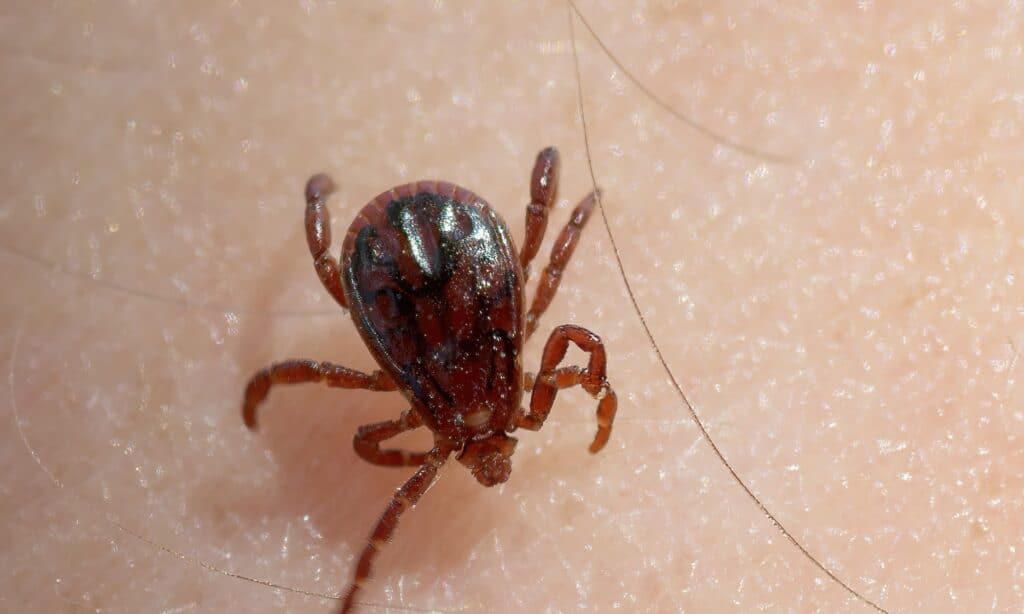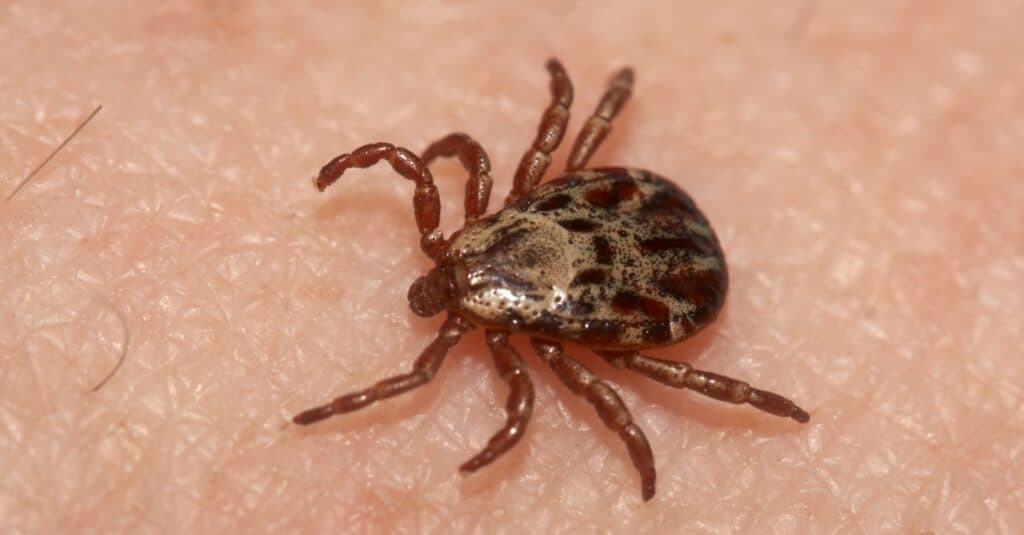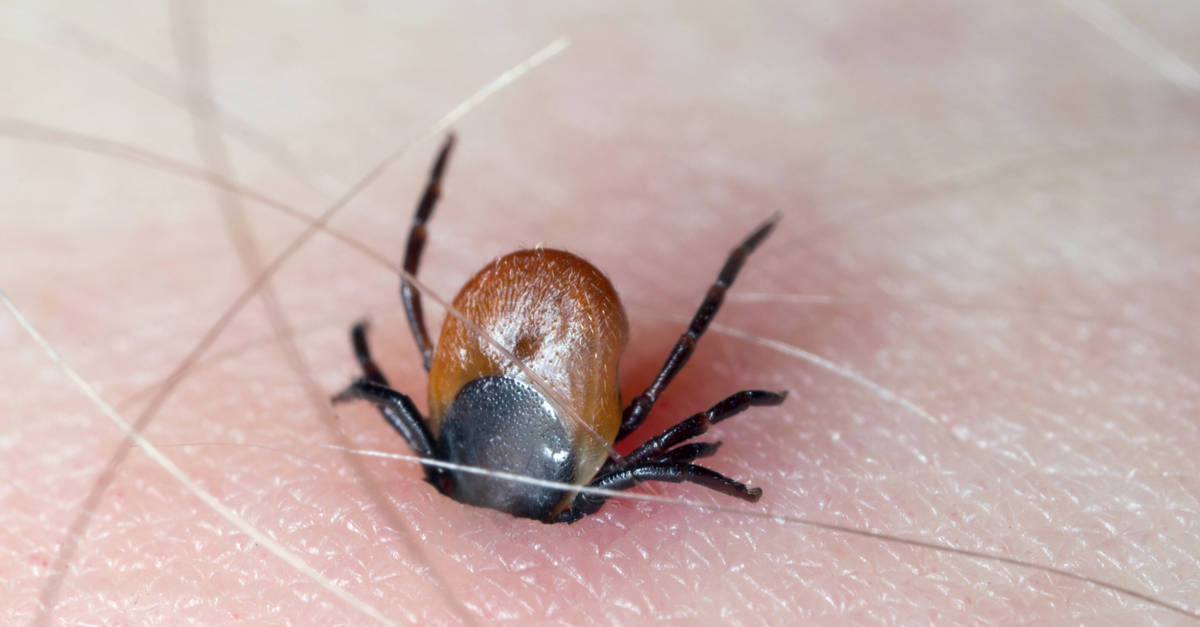Even though ticks are small, they can cause some pretty serious problems. Although they might look like insects, they are actually classified as parasitic arachnids that are part of the mite superorder Parasitiformes. Therefore, they are more closely related to spiders and scorpions than insects. An observant person will notice that ticks have four pairs of legs but no antennae, so they look like spiders. Additionally, ticks are capable of transmitting a few dangerous diseases, which makes them particularly interesting.
So have you ever wondered what ticks eat? Let’s discover more about this fascinating parasite by looking at its diet.
What Do Ticks Eat?

Ticks eat blood to survive.
©iStock.com/RobertAx
As ectoparasites, ticks consume blood in order to survive. They are known as obligate hematophages which means that they require blood to survive and progress through their life stages. In other words, they feed on the blood of mammals, reptiles, amphibians, and birds. It is important to note, however, that each species prefers a certain type of prey. Some ticks prefer human blood, while others prefer that of birds. There are also a lot of different species, and they all bite in different places. Some bite everywhere, and others bite mainly on the face of their prey or in the ears.
It is important to note, however, that ticks do not feed exclusively on blood. Besides blood, ticks also consume tissue fluids from their hosts. In addition to providing essential nutrients, this helps keep them hydrated. A tick will also sometimes ingest the cells from its host’s skin. This is called dermal feeding, which helps the tick shed its outer layer. As a result of feeding on the host’s dermis, a tick can also avoid being detected by them.
Having learned everything there is to know about the ticks’ diet, let’s learn all about how they get their food.
How Do Ticks Hunt and Forage For Food?

Ticks find their hosts by sensing heat, moisture, and vibrations in the body or by smelling their breath and body odors.
©iStock.com/cturtletrax
A tick’s ability to feed depends on its host. Despite being able to fast for long periods of time, they will eventually die without a host. According to CVBD, ticks detect their hosts through their breath and body odors, as well as through their body temperature, moisture, or vibration.
Common misconceptions about ticks include jumping onto their hosts or falling from trees. However, these animals cannot fly or jump. In many species of ticks, particularly Ixodidae, there is a position known as “questing.” As ticks search for food in their questing position, they cling to leaves and grasses by their third and fourth pairs of legs. Holding out their first pair of legs, they wait for an opportunity to grasp and climb onto passing hosts.
Depending on the tick species, tick saliva may contain thousands of different proteins, depending on how much protein a tick produces. Ticks are able to feed for over a week without being perceived by their hosts because they have proteins with anti-inflammatory properties called evasins. These evasins are being studied by researchers for the development of drugs against myocarditis, heart attacks, and strokes caused by chemokines.
What Do Baby Ticks Eat?
The life cycle of a tick is divided into four stages. There are four stages of development in a tick’s life: egg, larva, nymph, and finally adult. It is essential for a tick to feed on the blood of a host during each stage of its life to survive. In the early stages of larval development, larvae are not infectious to humans. At this stage, however, there is an increasing tendency for them to seek out smaller mammals as their first hosts. One of the most common mammals for them to feed on is the mouse. When larvae have finished feeding on a host and have become full of blood, they fall to the ground and begin to transition into their next life stage as nymphs.
As soon as they become nymphs, they begin to search for their next host in order to continue their life cycle. When a nymph spots a host that seems to be ideal for them, they will wait for it to pass by before latching on to it as soon as they make contact. During the fall, when the nymph has soaked up enough blood to be fully fed, it will fall off its host and become an adult at that time. It is common for ticks to feed on the blood of three different hosts throughout the course of their lives.
Are Ticks Dangerous To Humans?

Ticks can transfer a variety of diseases to humans through their bites.
©iStock.com/ironman100
It has been mentioned earlier that humans are just as susceptible to tick bites as any other mammal. As a starting point, note that most tick bites may not require medical attention. Those diseases spread by tick bites are known as tick-borne diseases. Depending on the source of the disease, these diseases can be caused by bacteria, parasites, or viruses. However, bacteria are the most common cause of these diseases.
Deer ticks, wood ticks, and others carry germs that cause diseases like Rocky Mountain spotted fever and Lyme disease. Rocky Mountain spotted fever (RMSF) is contracted by a tick that has been infected with the disease. The disease is caused by bacteria. As a result of RMSF, most people who fall ill will have a fever, headache, and rash as a result of their illness. If RMSF is not treated early with the right antibiotic, it may prove to be fatal if left untreated.
Currently, Lyme disease is regarded as the most prevalent vector-borne disease in the United States. Black-legged ticks that carry the disease transmit it to humans through their bites. The condition is characterized by fever, headache, fatigue, and erythema migrans, a rash on the skin. There is a high risk of infection spreading to joints, the heart, and the nervous system if left untreated.
What Eats Ticks?
Ticks are actually preyed upon by a number of animals, including birds, reptiles, and insects. In order to keep tick populations under control, these predators are essential. Some of these animals include lizards, guineafowl, chickens, squirrels, opossums, wild turkeys, frogs, and even ants and fire ants.
Thank you for reading! Have some feedback for us? Contact the AZ Animals editorial team.








